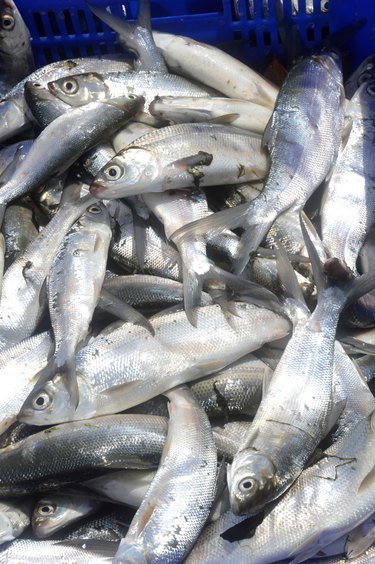
The milkfish, also known as bandeng or bangos, is a silver-colored Pacific salt-water fish that lays its eggs in shallow coastal waters and can withstand low-salinity water. It is a source of animal protein, B-complex vitamins and selenium, but it is also a significant source of fat, saturated fat, cholesterol and calories.
Macronutrients
Video of the Day
A 3-oz. serving of milkfish cooked with dry heat contains 162 calories, 22.4 g of protein, 7.3 g of fat, 2.9 g of saturated fat, 78 mg of sodium and 57 mg of cholesterol, according to the U.S. Department of Agriculture calculations. Protein accounts for roughly 55 percent of the calories and fat for 45 percent.
Video of the Day
Vitamins
The same serving of milkfish supplies 116 percent of the vitamin B 12, 44 percent of the niacin, 24 percent of the vitamin B6 and 15 percent of the pantothenic acid that the Food and Nutrition Board of the Institute of Medicine recommends adults consume daily. All four of these vitamins are water-soluble B-complex vitamins, and they play vital roles in metabolism; central nervous system function; skin health; and DNA, hormone and red blood cell formation. Milkfish also contains trace amounts of riboflavin, folate and vitamin A. Milkfish does not contain significant amounts of vitamins C, D, E or K.
Minerals
A 3-oz. serving of milkfish offers 25 percent of the phosphorus and the selenium adults should consume daily. Phosphorus is integral to red blood cell oxygenation, and selenium is essential to thyroid and immune function. Milkfish also contains trace amounts of calcium, iron, potassium and zinc.
Considerations
A serving of milkfish contains 20 percent of the saturated fat, 19 percent of the cholesterol and 9 percent of the total fat that MayoClinic.com advises adults to limit themselves to each day. Although milkfish does contain a significant amount of fat, 60 percent of the fat is heart-healthy monounsaturated fat, including omega-3 fatty acids, which are associated with decreased blood triglyceride levels, reduced blood pressure, enhanced immune function and an improvement in arthritis symptoms.
Serving Suggestions
Prepare milkfish as you would other fish. To lower your fat and calorie intake, choose cooking methods that require less fat or oil, including baking, broiling, steaming and grilling.
Warning
While milkfish, like all fish, is an excellent addition to any well-rounded diet, no diet that encourages the consumption of one food to the exclusion of others can be considered healthy. Consuming a single food can quickly lead to vitamin and mineral deficiencies. Consult your doctor before starting any weight loss diet.